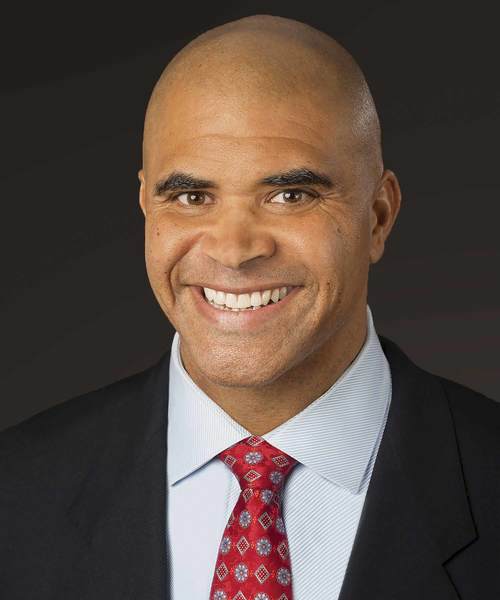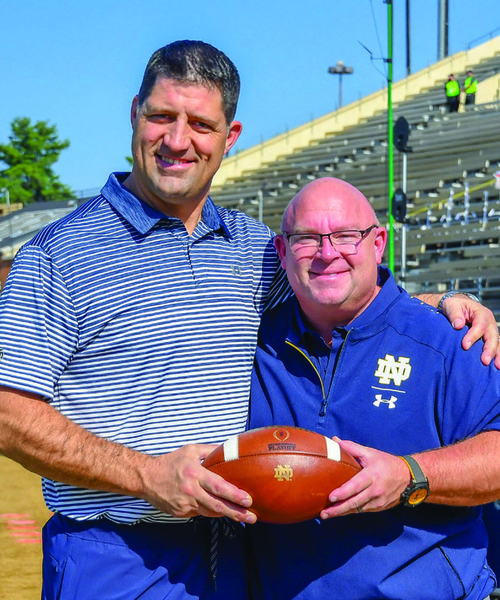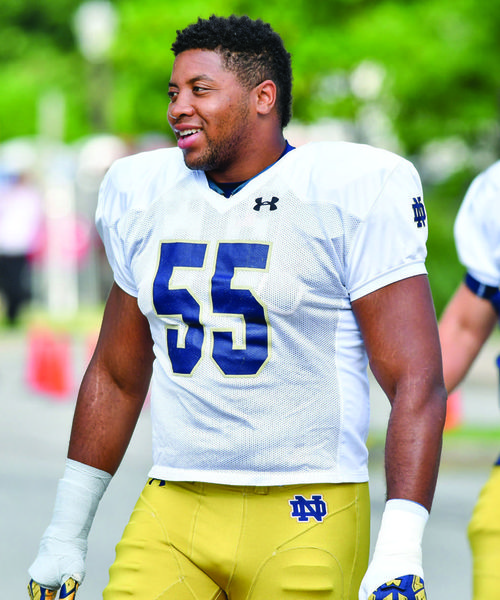
Aaron Taylor
Living to serve
The 2004 Indian Ocean earthquake struck the day after Christmas, with a powerful magnitude of 9.1 to 9.3, lasting a horrific 10 minutes, with the epicenter located off the west coast of Sumatra, Indonesia.
It triggered a series of the most destructive tsunami waves in history. Those waves surged throughout the Indian Ocean, some soaring as high as 100 feet, destroying more than 250 coastal communities, killing 230,000 people in 14 counties and displacing hundreds of thousands more.
It marked the first time in modern history such a profound natural disaster was so widely reported. I spent countless hours watching media reports covering the devastating and ensuing aftermath. Something about those waves triggered something in me as well.
I had been an accomplished football player. A two-time All-American. A Lombardi Award-winning offensive guard and team captain for Notre Dame. A first-round 1994 National Football League draft choice of the Green Bay Packers, the 16th overall pick. A Super Bowl XXXI champion. In 1998, I signed with the San Diego Chargers, but compounding injuries forced me to retire just two years later at the ripe old age of 28.
On paper, I thought I was the American dream: Young, financially independent, a homeowner, debt free—and seemingly not a care in the world.
But life is not lived on paper and, like many others, I struggled in my transition from the NFL into the “real world.” I just could not seem to find myself. I had an interest in teaching and I loved to travel, so I taught English in South America through a volunteer program called Teaching and Projects Abroad. Eventually, I enrolled in National University and got a multi-subject teaching credential, genuinely hoping to change the world, one runny nose at a time. Most importantly, however, I cleaned up my act. I stopped drinking and got sober and have been ever since.
Right before I was to start teaching elementary school full time in 2003, ABC Sports inexplicably called to offer me a job as a host of the network’s college football studio show. I had forgotten I had auditioned several months before. I was conflicted: Fame I did not want, and as it was pre-marriage/kids and before the market crash of 2008, it seemed money I did not necessarily need. But because I thought it was a once-in-a-lifetime opportunity, I seemingly betrayed my higher calling and reluctantly took the job.
After doing it for a year, I was having fun and checking all the boxes required for “success,” but I remained conflicted. On one hand, I was in the prime of my life in the middle of the hustle and bustle of New York City. But there was a quiet, yet persistent question that was demanding to be heard: “What are you doing with your life?” Looking back, it was a rhetorical question.
One day, while walking in Greenwich Village in New York, I came up with the answer. Instead of trying to pick between fame and money, why not have one impact the other? So, I started the Aaron Taylor Impact Fund, a donor-advised endowment whose mission is to bridge the gap between those who have and those who need. Instead of choosing between my television platform and helping people, I would use the one to help the other. I donated my entire second-year salary from ABC to the fund. Each year, I would decide where to allocate 80 percent of the fund, then I would roll the other 20 percent back into the account.
It only took one week for my Impact Fund brainstorm to become reality. That is the story of my life. Whenever I have made a decision that has been divinely planned, it has happened very quickly. To become a pro football player. To get sober. To marry Lina. It works this way: There is an interest, and there is a fear. Then, I say to myself, “Screw it!” And I step into my fears and trust all that is required to get to what is waiting for me. Magically, the world unfolds in a beautiful way. It feels very next level to me.
That throw-caution-to-the-wind-and-go-with-your-gut instinct is true of that 2004 Indian Ocean earthquake. I felt this deep need to go to Indonesia. I cannot tell you why. On January 25, 30 days after the earthquake, I was on a plane bound for Sri Lanka. I had no idea where it was. I did not have a place to stay. I did not know anybody there. I had brought along $30,000—I had put up $15,000 of my own money and had had it matched. I just trusted it would all work out.
I knocked on the door of the U.S. embassy and said, “I have come here to help.” A guy working in the Embassy was a Packers fan who recognized me, and he gave me the lay of the land. I set off for Kosgoda, where 4,000 families had been displaced. My plan was to build 40 temporary homes and a community center, using rubble from the brick schoolyard that had once served the children of the community as the literal and symbolic foundation of their new lease on life. Brick by brick. Up from the rubble and the leveled foundations. On day one, people stood in line to put in their applications for a house, so I figured my idea must be spot-on.
The next 10 weeks were the hardest and most rewarding I have endured in my life. Each day at 5 a.m., Jayantha, my contractor, drove me to the work site on a three-wheeled motorcycle called a Tuk-Tuk. His English was as poor as my Sinhalese (the native language of Sri Lanka), but we grew close through nonverbal communication and working side by side, day after day, in the sweltering tropical heat. Just as I became close to Prasanna Tennekoon, a young kid who was my translator. There were plenty of roadblocks and pitfalls along the way. Tsunami-soaked wood shrunk. Tools and materials were stolen. Fights broke out. Nerves were frayed. Through it all, Jayantha and I ground it out. Our strong bond was literally formed through blood, sweat and tears.
Finally, when everything was up and running, it was the closest I ever came to suffering an emotional breakdown. Exhilaration and exhaustion. My last day in Kosgoda, I pored over all of my receipts. I had pumped $27,000 into the economy, and I had $3,000 left over. So, I put the $3,000 into an envelope and presented it to Jayantha. When he opened it, he broke down. He cried so hard that he doubled over. It was four or five times his annual salary. I started crying, too, and my tears just kept coming. The only time I cried close to that hard was when my first son was born. Jayantha and I had profound gratitude for each other. He helped me. I helped him. The tears were the release of frustration, anger, tension and stress to get the work done. For those 10 weeks, Jayantha and I had gotten the best of each other.
There was an irony to my Sri Lanka experience. Not a single person ever moved into any of the houses. As it turned out, the older people would have rather stayed on the floors of their cousins’ homes further inland. However, they were preconditioned through years of British colonialism to take what they were given, whether they needed or wanted it or not. The mistake I made was building 40 temporary homes instead of just one. I learned very important lessons about my righteous Western know-it-all thinking. I had never truly understood that you must ask more questions of those you are trying to help to find out what they truly need—not just give people what you think they need. That is the only way you can make a more permanent and lasting change. By asking enough questions until there is no other course to take than the one that lays before you. I have carried that valuable lesson with me ever since.
What is my influence for giving to others? It is in my DNA. I was raised by my mother, Mardi, a single parent who literally brought home birds with broken wings and rooted for the Native Americans in the old Westerns as a kid. She was a pediatric intensive care unit nurse for 25-plus years at Children’s Hospital in Oakland, California, followed by a 10-year career as a foster mom for drug-addicted babies. She just retired after 15 years of service with hospice. I certainly watched the nature of her care-giving. It was implicit, not explicit.
My earliest memory of charity is finding a wallet on the sidewalk while walking home from eighth grade. It had an ID and a ton of money in it. My mother used it as an opportunity to teach me a lesson. She asked me, “What should we do? Keep it or give it back?” I thought long and hard, and I decided to give it back. We drove to find the owner of the wallet and returned it. Shortly thereafter, at a point when money was particularly tight in our house, a Christmas wreath showed up with $300 to $400 woven through it. Anonymously. No name. No card. Just money. To this day we have both wondered. We wondered who delivered it, but I wonder if those two incidents were related?
My next memory of charity is buying cleats for Marlon Blanton, my teammate at De La Salle High School in Concord, California. His nickname was Rio, and he was our star running back. His family had less money than we did, and the school could not provide his shoes. I needed new cleats, too. I asked my mom if we could buy his first, and then we bought mine the following month, when there was a little extra money again. I have always been inclined to listen to that voice that nudges me toward helping people, being of service, being a good teammate. What I have learned over the years is that when I do that, an unintended consequence is that it tends to come back to me somehow, some way, 10-fold. The more I am of service, the more I just seem to receive. It is almost as if it’s designed that way.
At Notre Dame, I was always open to fans. I participated in charity work. I visited children’s hospitals and did all the obligatory things that one in my position was asked to do. But let me be honest. Early on I struggled with the idea of giving just for the sake of giving. Genuinely helping others was what I wanted to do, but there was a much more hidden motivation: I got attention for it and that attention-seeking often led me astray. I did not realize that the point of service was service. I had a juvenile and limited perspective of the unintended consequences of my actions. Back then, I was helping people, and it was a good story … but I was missing the point.
When I played for the Packers, I started the Secret Santa program my last two years with the team. It was one of those organically formed ideas that later seemed divinely inspired. Because the team asked players to do community service, I volunteered with Paul’s Pantry, which was more than an emergency food bank. Its goal was to provide families with enough food each week, for as long as needed, so that they could use their money for shelter, utilities and other necessities—and avoid becoming homeless.
Something about Paul’s Pantry spoke to me.
I got very involved, and at Christmastime a quiet, yet distinct thought flashed through my head, “Man, it would be cool if we took Secret Santa and integrated it into the food bank.” The idea was that players would sponsor a specific family and provide one item of need and one item of want per family member. Well, the guys ate it up. They got their wives and kids involved. They did it on their own time and with their own money. They did it all anonymously. Most of them came back to me and said, “We love this! Give me more families to shop for!” I collected all of the stuff at the stadium and took it to the food bank. As the families came to Paul’s Pantry to pick up their groceries, they were given the wrapped presents. It had a positive impact on everyone involved.
During college football season, my family and I live in New York City because of my job as an analyst for the CBS Sports Network. The rest of the year, we live in San Diego. When in New York, I will often carry food for people on the streets or I will go out of my way to buy them something warm to eat. I talk to my kids about the differences between poor life choices and “bad luck.” I want them to know that, but I also want them to know that making eye contact and looking at someone with dignity, hope or a simple smile can go a long way. For both of you.
My work with the Christmas Day feeding of the homeless at Horton Plaza in downtown San Diego.
My mentoring with The AthLife Foundation to help athletes with education, career development
and life skills development for high school, college, professional and post-professional athletes.
My creation of The Joe Moore Foundation for Teamwork, honoring my offensive line coach at Notre Dame.
My charitable efforts are all over the spectrum. They have one thing in common: They tug at my heartstrings. Each endeavor becomes more profound and more inclusive than the one before. It is the sum of all that has gone before. I call it my spiritual fruitcake. I freely give as I have received, and it all just seems to come back.
I have learned that the world is actually an abundant place, and when I operate from an expectation that there will always be enough/adequate amount of XXX to meet my current and anticipated needs, amazing things start to happen in my world and in everyone else’s around me as well.
I have always been compelled to help. To lead. Even as a kid. When I was in my 20s and 30s, I used to think grandiose thoughts about changing the world—like I needed to be Martin Luther King, Gandhi, JFK or Rosa Parks. But as I am rounding second base, I am realizing that the best way to change the world is on a much smaller and consistent scale. By the way I treat my wife (or the employee behind the cash register) in front of my two sons. By the way I show up to those around me on a daily basis. Is the world … or are the people … better off because we have crossed paths? I want the answer to be yes, and a lot of times it is. But not always, so I keep working at it.
We are all part of the same closed ecosystem. Physically. Spiritually. Emotionally. Just as the cells in my ear lobe have no idea about the cells that live in my big toe—they are still directly related to one another even if they are unaware of the other’s existence. So how we show up in the world affects the world. Good and bad. And it is a good thing I am still young, as I have more of me to “fill up” … like a spiritual bank account that I had overdrawn due to the transgressions of my NFL years and trying to live up to someone else’s idea of success. I was off the mark … emptied out … and service fills me back up and keeps me on course.
Whenever I have chosen to be of service, ultimately it comes from a place of gratitude. I do not give because I feel I have to. I now give because I am able to. And it makes me feel good inside. Honestly, I do it selfishly. And I am finally at a place in my life where I can acknowledge that and be okay with it. The irony is that when I denied that part of me that felt good when I helped, I cheated myself (and others) as this hidden agenda/need led me astray. But once I embraced/accepted it, it seemed to free something up … and I do not know how or what … but that was a barrier that I personally needed to get past to allow me and others to fully experience the power of service. I think people need to hear that. It took me a long time to be okay with that, but thankfully that guilt no longer holds me back, and the mutual benefit it has created for myself and others has significantly impacted all of our lives for the better.
My gut tells me that my particular “what” and “how” of service is not nearly as important as why I did or what I learned along the way. There are an infinite number of people and causes that need support. It is an equal opportunity philanthropy world. It has been said, “To whom much is given, much is required.”
Yet there is another reality that often is less discussed: “To whom much is given, much is possible.”
And I cannot possibly wait to see what God has in store for me moving forward.

